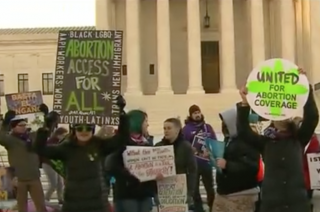 On Monday, the Supreme Court struck down a controversial Texas law with a 5-3 decision in what had been regarded as the most significant abortion case in years. The case, Whole Woman’s Health v. Hellerstedt, is about a 2013 Texas state law that placed two new restrictions on abortion clinics. One says that abortion clinics needs to be up to the same standards as surgical facilities, and the other requires doctors who perform abortions at clinics to be able to admit patients to hospitals.
On Monday, the Supreme Court struck down a controversial Texas law with a 5-3 decision in what had been regarded as the most significant abortion case in years. The case, Whole Woman’s Health v. Hellerstedt, is about a 2013 Texas state law that placed two new restrictions on abortion clinics. One says that abortion clinics needs to be up to the same standards as surgical facilities, and the other requires doctors who perform abortions at clinics to be able to admit patients to hospitals.
The controversy over the law is that the restrictions place a significant burden on clinics, which would have to shut down if they could not comply. That could result in there being far fewer clinics for women to go to, with many living more than 150 miles from the nearest clinic. Wait lists for appointments could also increase by several weeks, and Texas law already bans abortion after 20 weeks of pregnancy.
Perhaps most interesting about the case is the change in strategy by those looking to restrict abortion. Past cases generally focused on the life of the fetus, but this case focuses on the health of the woman. In the end, the Court decided that the restrictions placed an undue burden on women seeking abortions, and noted the District Court’s finding that before the law was passed, there was “no significant health-related problem for the new law to cure.” Additionally, the Court found that since the prior law had already required doctors who perform abortions to have a “working arrangement” with other doctors who could admit patients to hospitals, the new law did not actually advance a legitimate interest of the state.
The Court also wrote that the requirement for facilities to have the same standards of surgical facilities provided “few, if any health benefits for women,” while placing an undue burden on women. The Court recognized the District Court’s findings that before the Texas law went into effect, there were more than 40 abortion clinics in the state, but that if the surgical standards went into effect, that number would go down to seven or eight.
The Court’s opinion, written by Justice Stephen Breyer, states that “neither of these provisions offers medical benefits sufficient to justify the burdens upon access that each imposes.” The Texas law was therefore deemed unconstitutional since each restriction “places a substantial obstacle in the path of women seeking a previability abortion, each constitutes an undue burden on abortion access … and each violates the Federal Constitution.” Justice Ginsburg noted in a concurring opinion, “Many medical procedures, including childbirth, are far more dangerous to patients, yet are not subject to ambulatory surgical-center or hospital admitting-privileges requirements.”
Breyer’s opinion was joined by Justices Anthony Kennedy, Ruth Bader Ginsburg, Sonia Sotomayor, and Elena Kagan. Justices Clarence Thomas and Samuel Alito wrote dissents, with Chief Justice John Roberts and Justice Thomas joining Alito’s dissent.
Justice Alito said that the case should have failed on procedural grounds because a similar case had already been brought, and failed. Alito went on to say that despite that, the Court should have used a severability provision to only strike certain parts of the Texas law instead of the whole thing. Alternatively, Alito said, the Court should have sent the case back down “for a remedy tailored to the specific facts shown in this case.”
Justice Thomas disagreed with the very idea of allowing the case in the first place, saying that doctors and clinics should not be able to invoke a woman’s right to an abortion as a basis for their own case. Thomas also wrote that the Court’s opinion strayed from the “undue burden” test first used in Planned Parenthood v. Casey. Thomas said that in this case, the Court balanced the burden with the law’s potential benefits, which the Court did not do in Casey.
Texas State Attorney General Ken Paxton said in a statement in response to the decision:
HB2 was an effort to improve minimum safety standards and ensure capable care for Texas women. It’s exceedingly unfortunate that the court has taken the ability to protect women’s health out of the hands of Texas citizens and their duly-elected representatives.
The decision comes as the Supreme Court ends its current term. It will go on recess for the summer, and will resume hearing cases in October.